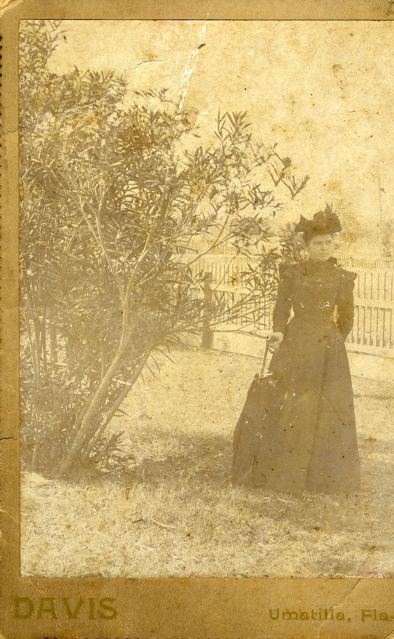Every fall my mother used to open up the footlocker and unfold our warmer clothes, faintly smelling of mothballs. Flip-flops disappeared for the year—we’d probably worn them through in the long summer, anyway—and out came garments we hardly remembered: toggled winter coats, corduroy pants with their funny swish, long-sleeved shirts in mysterious late-70s patterns. We hadn’t picked out these things. We had acquired them at garage sales or in boxes of hand-me-downs, but that didn’t make us like them any less. Annually, these clothes had the strange appeal of seeming to belong to other children, of promising to make us other children when we put them on.
When my mother quit doing this, I don’t remember. I suppose we grew up and our now-bulkier winter things could be better stored in big Tupperwares under our beds. And then, there was the fact that we lived in Florida—north Florida, where there is a seasonal change known to residents as “winter,” but Florida nevertheless. In fact, looking back, I can hardly understand what it was all about, the footlocker, the mothballs. As a college student in Florida, I knew I had gloves, but I had no idea where they were. My warmest winter garment in regular use was an unlined leather jacket.

Maybe the winter clothes were a holdover from my mother’s own childhood. She grew up in Florida too, but somehow I imagine the world was a little colder then. My grandmother (another Floridian) routinely wore wool scarves and lined skirt suits. And I have a turn-of-the-century photograph of some mysterious old Aunt Amy standing in a full-length, long-sleeved wool dress, digging the point of her umbrella into the parched grass of central Florida. She looks unhappy, but not quite melting in her heavy clothes. Yes, the Little Ice Age, that must be it. Ended in about 1985, right?
Or, perhaps the winter clothes had to do with our annual trip to North Carolina: one week in the mountains every October. The first year we went, I was four-and-a-half, and it was the farthest north I’d ever been. We stayed that year in a house belonging to a minister friend of my grandmother’s, or to a minister friend of her minister—at any rate, it was a preacher’s house, a big house, a big old box of a house set in a sloping yard full of fallen leaves. About the actual inside of the house I remember very little, but I remember its basement. A basement! This was practically unheard of in Florida. And this basement had little windows high in the walls—too high for us to see out of, but a little swing hung from the basement rafters, and at the top of its arc my brother and I could see the brown leaves that lay bedded in all around the house.
A swing in the basement of a preacher’s house? What kind of gothic horror had we stumbled into? Surely I remember it wrong. That may be: I’ve never asked anyone in my family about this memory of mine. I like it too much; even if it’s wrong, I’m keeping it.
That is how childhood memories work, isn’t it? No one is ever quite sure about them. “I remember it this way—which is funny, because it couldn’t have been.” Or, as my father says in preface, when he’s uncertain whether he’s retelling his memory or someone else’s or a memory reconstructed from a photograph: “This may be an implanted memory.” For all their central vividness—of first-felt emotion, of self-making—childhood memories can be strangely fuzzy around the edges.
I recall a few I eventually had to reject as impossible. One involved my grandmother telling how my father (aged two or three) tumbled off the top of a two-story building and cracked his head open. In another, a pet crayfish marvelously revived—not only after death, but after I had chucked its body into the trash. A closer acquaintance with the consistency of the universe obliged me to give them both up: cracked heads stay cracked, dead crawdads stay dead. And the giving up, after some initial puzzlement, was easy: one must have been a misunderstanding, the other a dream confused with life.
I would be a different person if I had kept those memories; I gave up them up to become myself.

The footlocker held more than our warm clothes; in lower layers, it preserved cast-offs of my mother’s, things she was done wearing. Did she save them for me? I did eventually take a pintucked smock, red with white cuffs and collar and a pattern of tiny moons and suns. But the fringed suede miniskirt and vest set—I never even tried it on, and I don’t know why. My mother quit mentioning it was there. Her wedding dress, too—I used to see that every so often, lying folded under the floating shelf in the footlocker, off-white, empire-waist, with daisy chain embroidery. She didn’t bring it up when I came to be married, and neither did I.
Sometimes it seems that this whole set of memories—the footlocker, the strangers’ clothes (because my mother’s old clothes, too, described a stranger, someone I would never know), the house in Dillard with the basement swing—belongs to someone else. It’s tinged with the sunset orange of the seventies, a decade I don’t remember, though it made me. When I look this way, I become historical to myself, as curious as that photo of Aunt Amy. What is she thinking, how old is she? What does she already know? What has she given up to get here?
Lightsey Darst is a writer, critic, and teacher based in Durham, NC.
Get Walker Reader in your inbox. Sign up to receive first word about our original videos, commissioned essays, curatorial perspectives, and artist interviews.